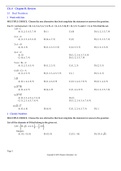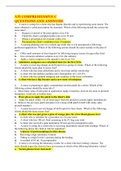Exam (elaborations)
AQA A level Biology Topic 1 - Biological molecules notes (A* achieved)
Grade achieved: A* I have put so much hard work into making this set of notes. Achieving an A* and constantly getting top grades at school proved that my hard work paid off. My notes are mostly based on 10+ years of mark schemes from past papers, and some from revision guides + online resour...
[Show more]









